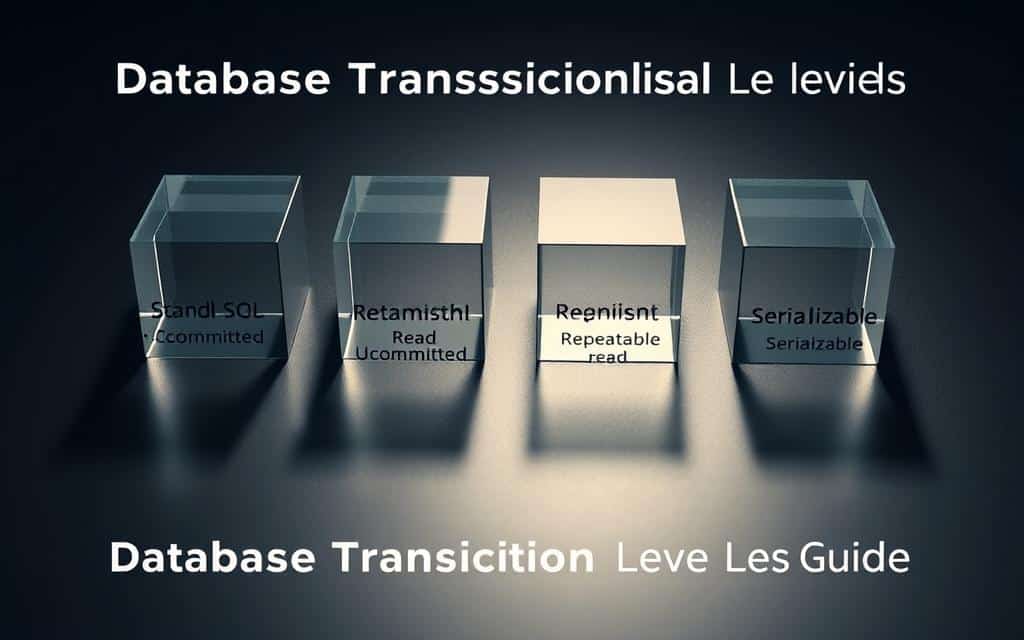Have you ever wondered why two apps reading the same data can show different results at the same time?
This guide gives you a clear, plain-English tour of how systems balance concurrency and correctness. You’ll learn the common names for the options and why modern systems often pick one by default.
We explain key ideas—like how choosing a level affects performance, user experience, and risk—in simple terms. You’ll get practical rules of thumb for real workloads, from shopping carts to bank transfers.
Expect short explanations of lock-based behavior versus row-versioned snapshots, and plain definitions of dirty, non-repeatable, and phantom reads. By the end, you’ll have a decision framework to pick the right option and a few tuning tips to reduce surprises under load.
Start here: what isolation means in ACID and why it matters now
Why must one operation ‘feel alone’ even when many run at once on the same system?
In ACID, isolation makes each transaction behave as if it has exclusive access to shared resources. That promise stops other concurrent activity from exposing half-finished work or rolled-back changes.
What changes when you pick a different isolation level? You decide whether reads take locks, how long read locks last, or whether reads get a consistent snapshot of committed data. Those choices affect correctness, latency, and throughput.
When you tune this setting, you reduce the risk that a read sees temporary or incorrect data — and avoid business mistakes driven by bad values. Isolation is not binary: it’s a spectrum you use to balance safety and speed.
- Protects reads from uncommitted changes.
- Controls lock behavior or returns a snapshot.
- Gives you a practical lever to shape app behavior under load.
Why transaction isolation levels affect real apps and users
Why can a product look available on your screen one moment and sold out the next?
Imagine thousands of shoppers hitting Costco.com when a hot item drops. Many reads happen at once, and some readers see stale stock counts. That gap is not magic — it’s how the chosen level handles concurrent activity.

What you feel as a user matters: a cart that later fails at checkout creates frustration and lost sales. Higher settings reduce those errors but can add latency or retries when many requests compete for the same rows.
- Reads during heavy concurrency may block, retry, or return older committed data depending on the level.
- Lower settings boost throughput but can leak inconsistent states to users.
- For product pages, slight staleness might be okay; for payment capture, you need stronger guarantees.
| Use case | User impact | Trade-off |
|---|---|---|
| Catalog browsing | Minor inconsistencies OK | Favor speed and throughput |
| Cart checkout | High confidence required | Prefer stricter guarantees, expect retries |
| Payment capture | Zero tolerance for error | Use strongest settings despite latency |
Data anomalies isolation levels are designed to prevent
What happens when concurrent activity makes a simple read give you the wrong impression? Below are the common anomalies you must consider and how they affect real systems.
Dirty reads: seeing uncommitted data
A dirty read occurs when your session reads uncommitted data written by another session. If that writer rolls back, the data read never actually existed. Dirty reads can mislead dashboards and reports.
Non-repeatable reads: values change between statements
You may read a value, then see a different value later because another session committed an update. This breaks assumptions about stable reads and can skew sums or totals.
Phantom reads: set of rows changes between reads
Run the same query twice and you may see new or missing rows. Those phantoms come from concurrent inserts or deletes that committed between your reads.
Write skew: constraint violations from concurrent reads/writes
Two sessions read overlapping state, make legal updates based on that state, and together they violate an invariant. Write skew is subtle but can break business rules.
- Dirty reads — immediate, visible risk.
- Non-repeatable and phantom reads — affect totals and workflows.
- Write skew — can silently break policies.
| Anomaly | Symptom | How to stop it |
|---|---|---|
| Dirty reads | Stale or rolled-back values | Prevent with stronger isolation or read committed |
| Phantoms | Changed result sets | Use locking or snapshot behavior |
| Write skew | Policy violations | Use serializable guarantees or explicit checks |
database transaction isolation levels in the SQL standard
How do the four standard settings map to real risks and real performance in your app? Below is a crisp, practical tour of each option and the trade-offs you should expect.

READ UNCOMMITTED: level 0 locking and why to avoid it
READ UNCOMMITTED issues almost no shared locks and allows dirty reads. That means a read can see uncommitted changes that later vanish.
Avoid for transactional work: it increases data surprises and breaks correctness guarantees.
READ COMMITTED: popular default, prevents dirty reads
READ COMMITTED stops dirty reads by showing only committed values per statement. But values can change between statements inside the same session.
This is the common default isolation level in many systems — a pragmatic balance of safety and throughput.
REPEATABLE READ: stable row values within a transaction
REPEATABLE READ holds shared locks on rows you read until commit. That stabilizes values across statements in the same unit of work.
It still permits phantoms — new rows can appear unless you add range protection.
SERIALIZABLE: full isolation with potential retries
SERIALIZABLE adds range locks so repeated statements see the same set of rows. It prevents dirty, non-repeatable, and phantom reads.
Expect more blocking or retries: use this when correctness across statements is critical, such as payments or account updates.
- Higher levels reduce anomalies but increase contention.
- Many systems default to READ COMMITTED — check that when you migrate apps.
- Use the lowest level that meets your correctness needs and plan for retries at higher levels.
| Level | Main protection | Trade-off |
|---|---|---|
| READ UNCOMMITTED | None — allows dirty reads | High risk, high throughput |
| READ COMMITTED | Prevents dirty reads | Values may change between statements |
| REPEATABLE READ | Stable row values | No phantoms protection by default |
| SERIALIZABLE | Prevents phantoms and others | More blocking, possible retries |
Snapshot isolation and row versioning explained
What if every read in your session saw a frozen view of the world from the moment you started?
How snapshots return committed versions as of start time
With snapshot isolation, your work reads committed versions of data as they existed at the transaction start. Changes committed by others after that point are not visible to you.
This gives you a consistent, non-blocking read view—useful for reports, dashboards, and analytic queries.
SQL Server options and practical rules
Enable ALLOW_SNAPSHOT_ISOLATION = ON to start explicit snapshot transactions. Set READ_COMMITTED_SNAPSHOT = ON to make read-committed use row versioning per statement.
Remember: you can’t switch into snapshot mode mid-work, and snapshot transactions still see their own updates.
When snapshot beats locks for read-heavy workloads
- Readers don’t take shared locks under row versioning, so reads rarely stall writers.
- You avoid dirty reads while reducing read-write contention.
- Azure SQL defaults to READ_COMMITTED_SNAPSHOT, easing migration for many apps.
| Setting | View | Best for |
|---|---|---|
| ALLOW_SNAPSHOT_ISOLATION | Transaction-wide snapshot | Consistent multi-statement reads |
| READ_COMMITTED_SNAPSHOT | Statement-level versions | High-concurrency reads |
| Locks | Blocking reads/writes | Strict serial behavior |
Choosing the right isolation level for your use case
Picking the right setting comes down to one question: what errors can you tolerate in real users’ flows? Start by listing the anomalies that would break billing, compliance, or trust. That simple step narrows choices fast for concurrent transactions.
A simple decision framework for concurrent transactions
Answer: which anomalies are unacceptable — dirty reads, non-repeatable values, phantoms, or write skew?
- If only committed data is needed, and small view shifts are acceptable, pick READ COMMITTED.
- If you need a stable view across many statements, favor REPEATABLE READ or snapshot isolation for read-heavy work.
- For complex multi-statement logic that must see identical rows and values end-to-end, use SERIALIZABLE and plan for retries.
Banking and payments: when SERIALIZABLE is required
Money transfers and payment capture demand the strongest guarantees. Use SERIALIZABLE so the set of rows and the values you act on stay stable.
Expect conflicts and retries: treat retries as normal and implement an idempotent retry loop in your app.
| Use case | Recommended level | Why |
|---|---|---|
| Catalog pages | READ COMMITTED | Fresh enough, high throughput |
| Analytics reads | REPEATABLE READ | Stable multi-statement views |
| Payments | SERIALIZABLE | Prevents phantoms and write skew |
Finally, document your default isolation level and override per workload. That helps teams match user expectations with system behavior.
Implementing and tuning isolation levels in practice
Ready to set a session-level behavior that matches your app’s concurrency needs? Below are clear, practical T‑SQL examples and the common gotchas you will hit while tuning.
SET TRANSACTION ISOLATION LEVEL in T‑SQL with examples
Use SET per session, then BEGIN TRANSACTION and COMMIT when your statement sequence finishes. Syntax:
SET TRANSACTION ISOLATION LEVEL { READ UNCOMMITTED | READ COMMITTED | REPEATABLE READ | SNAPSHOT | SERIALIZABLE }
Example workflow:
- SET REPEATABLE READ;
- BEGIN TRANSACTION;
- SELECT … FROM orders WHERE id = 123; — stable row reads
- COMMIT;
Gotchas: lock behavior, retries, and table hints
When READ_COMMITTED_SNAPSHOT = OFF, reads take shared locks; when ON, reads use row versioning. SNAPSHOT needs ALLOW_SNAPSHOT_ISOLATION = ON and you cannot switch into it mid-work.
Remember: updates always acquire exclusive locks and hold them until the transaction completes. Overriding behavior with hints like READCOMMITTEDLOCK or HOLDLOCK can fix a single statement but may create surprises under load.
| Setting | Behavior | When to use |
|---|---|---|
| READ COMMITTED | Shared locks or row versions per statement | Default, balanced throughput |
| REPEATABLE READ | Holds shared locks on read rows until commit | Stable multi-statement reads |
| SNAPSHOT | Row versioning for non-blocking reads | Read-heavy mixed workloads |
| SERIALIZABLE | Range locks prevent phantoms | Strong correctness, expect retries |
Bringing it all together for reliable, high‑concurrency systems
How do you balance real-world speed with the guarantees users rely on at checkout? Start by treating isolation as a product decision — it shapes what users see and when a transaction completes.
Calibrate by risk: pick the level isolation that prevents the anomalies you cannot tolerate, and accept some throughput trade-offs where money or policy is involved.
Build resilient code paths that handle retries when another transaction conflicts. Use versioned reads for read-heavy work to cut blocking, and use locks or stronger settings for critical flows.
Measure end-to-end — latency, conflicts, and when a transaction completes — and document defaults and exceptions. Prototype under load to verify what a transaction reads and writes over time matches your invariants.